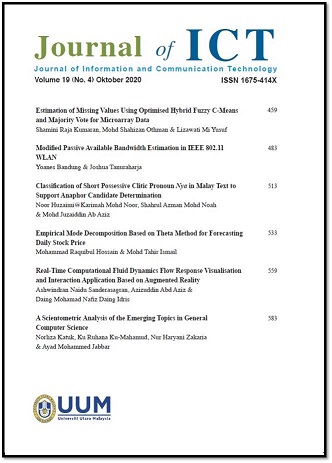APPLICATION OF ARTIFICIAL NEURAL NETWORKS IN THE CLASSIFICATION OF CERVICAL CELLS BASED ON THE BETHESDA SYSTEM
Keywords:
RBF neural network, HRBF neural network, MLP neural network, HMLP neural network, cervical cancer, diagnostic systemAbstract
Neural networks have been used in the medical field in various applications such as medical imaging processing and disease diagnostic technique. In this paper, we investigate the capability of two conventional neural networks as an intelligent diagnostic system. In particular, the radial basis function (RBF) and multilayered perceptron (MLP) neural networks were used to classify the type of cervical cancer in its early stage. The study is divided into two stages. In the first stage, we investigate the applicability of neural networks to classify cervical cells into normal and abnormal cells. In the second stage, we classify cervical cells abnormality into three classes based on The Bethesda Classification System; normal, low-grade squamous intraepithelial lesion (LSIL) and high-grade squamous intraepithelial lesion (HSIL). Diagnosis obtained using RBF and MLP neural networks gave promising results. Nevertheless, classification of abnormal cells into LSIL and HSIL yielded unsatisfactory results. In order to address this problem, this study adopted two hybrid neural networks namely hybrid radial basis function (HRBF) and hybrid multilayered perceptron (HMLP) networks in order to improve the performances of conventional neural networks. The overall diagnostic performance was measured using accuracy, sensitivity, specificity, false negative and false positive analysis by comparing to the diagnoses made by pathologists. This study indicates that HMLP network produces better overall diagnostic performance than the MLP, RBF and HRBF networks.
Additional Files
Published
23-03-2005
How to Cite
Mat Isa, N. A., Mashor, M. Y., Othman, N. H., & Zamli, K. Z. (2005). APPLICATION OF ARTIFICIAL NEURAL NETWORKS IN THE CLASSIFICATION OF CERVICAL CELLS BASED ON THE BETHESDA SYSTEM. Journal of Information and Communication Technology, 4, 77–97. Retrieved from https://e-journal.uum.edu.my/index.php/jict/article/view/8055
Issue
Section
Articles

 2002 - 2020
2002 - 2020


























